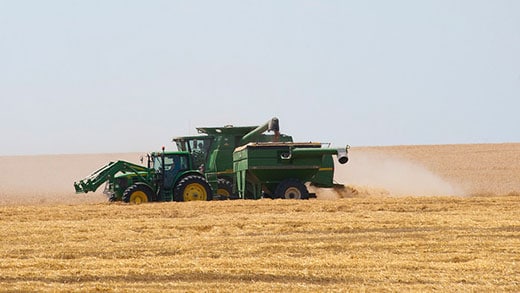The Economic Research Service says the number of U.S. wheat farms has dropped substantially over time. Since 2002, the total number of wheat farms fell by over 40 percent, from 169,528 in 2002 to 97,014 in 2022.
According to the ERS, the reduction in the number of farms reporting wheat harvested area occurred across all wheat classes. The number of farms producing durum wheat saw the largest percentage drop, down nearly 60 percent from the 2002 Census and 30 percent from the 2017 Census. Only five states saw increases in the number of wheat farms.
The 2022 Census of Agriculture showed that 8 States accounted for 54 percent of the total number of wheat operations in 2022. Kansas alone accounts for 15 percent, or 14,520, wheat operations, followed by North Dakota and Ohio with 8,053 and 7,604 total operations, respectively.
On average, the States with the highest wheat area per farm are located in the northern States such as Montana, Washington, and North Dakota. Each of these States has an average wheat area of 750 or more acres per wheat-producing farm. States located in the eastern half of the United States tend to grow fewer acres of wheat per farm, with several States in the Corn Belt growing 100 acres of wheat or less per farm.
In addition to the decline in wheat farms, wheat production is down slightly but has been variable year to year. The ERS says annual wheat production ranged from about 1.6 billion bushels in marketing year 2002-2003 to as much as 2.5 billion bushels in 2008-2009. However, wheat production didn’t exceed two billion bushels from 2017 through 2023.
One major reason for the decline in wheat production and area over time is that in some areas of the country wheat has become a rotational crop that is mixed into rotations with more profitable corn or soybean crops.
According to the USDA, the value of production less operating cost for wheat, which is a measure of profitability, has grown from $101.72 per acre in 2017 to $185.26 per acre in 2022. The same measure of profitability for corn has more than doubled from $273.77 per acre to $654.46 per acre, more than 3 times that of wheat. The value of production less operating costs for soybeans has also grown from $296.64 per acre in 2017 to $441.53 per acre in 2022.
Additional factors include changing farming practices, the development of seed varieties for corn and soybeans that are more conducive to growing conditions in areas traditionally planted to wheat, and other technological developments.
Overall, the number of wheat farms continues to shrink across all but the largest farm sizes. The average farm size continues to grow as the number of smaller farms declines and larger farms increase in number.
###
NAFB/USDA


